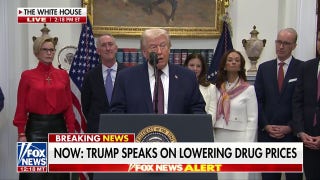Government spending to blame for inflation spike, San Francisco Fed study says
COVID-19 spending cause US inflation to rise by 3%, researchers say
Federal Reserve is ‘answer’ to bringing inflation down: Former Obama economist
Former Obama Economic Council Chairman Jason Furman says Fed Chair Jerome Powell needs to do more to tackle inflation.
Ask Democrats and Republicans what is to blame for high U.S. inflation, and they would point their fingers at extremely different culprits.
While the White House has identified supply-chain bottlenecks and other pandemic-induced disruptions in the economy for the recent price spike, GOP lawmakers have pinned it on the president's massive spending agenda.
WHERE ARE SURGING CONSUMER PRICES HITTING AMERICANS THE HARDEST?
But now researchers at the Federal Reserve Bank of San Francisco are weighing in on the topic – and they say that massive government spending during the coronavirus pandemic has caused U.S. inflation to surge more than in other developed economies.
"Fiscal support measures designed to counteract the severity of the pandemic’s economic effect may have contributed to this divergence by raising inflation about 3 percentage points by the end of 2021," wrote Òscar Jordà, Celeste Liu, Fernanda Nechio and Fabián Rivera-Reyes in the San Francisco Fed's weekly Economic Letter.

Customers browse food stalls inside Grand Central Market on March 11, 2022 in downtown Los Angeles, California. ((Photo by Patrick T. FALLON / AFP) / Getty Images)
In the span of just two years, Congress unleashed a torrent of federal money to shield the economy from the coronavirus pandemic, approving roughly $6 trillion in relief measures. Lawmakers approved about $2 trillion under Biden and $4.1 trillion under former President Trump, according to a COVID money tracker published by the Committee for a Responsible Federal Budget, a nonpartisan organization based in Washington.
The majority of the money allocated for emergency spending — close to $4 trillion — stemmed from two pieces of legislation: the CARES Act, passed in March 2020, and the American Rescue Plan, passed in March 2021. The remaining money came from the Response and Relief Act (December 2020), Families First Coronavirus Response Act (March 2020) and the Paycheck Protection Program and Health Care Enhancement Act (April 2020).
The sheer size of pandemic-related spending in the U.S. is entirely without precedent: During the 2008 financial crisis, for instance, the Obama administration approved a relief package roughly half the size of the American Rescue Plan, and a fraction of overall relief efforts this year and last.
INFLATION TOPS AMERICANS' BIGGEST ECONOMIC CONCERNS, GALLUP SURVEY SHOWS
Still, the San Francisco Fed economists cautioned that without such astronomical levels of federal spending, the U.S. risked sliding into a years-long recession with stubbornly high unemployment.
"Without these spending measures, the economy might have tipped into outright deflation and slower economic growth, the consequences of which would have been harder to manage," they wrote.

President Joe Biden signs the American Rescue Plan, a coronavirus relief package, in the Oval Office of the White House, March 11, 2021, in Washington. (AP Newsroom)
Core inflation, which strips out the more volatile measurements of food and energy, started 2021 below 2% on an annual basis and ended the year above 5%, the highest rate in decades. By comparison, inflation among countries in the Organization for Economic Cooperation and Development countries rose at a more gradual pace.
To compare fiscal stimulus in the U.S. with OECD nations, the researchers used an index of real disposable income to determine how much support was received by American households. They identified two distinct spikes in the U.S. that correlated with the American Rescue Plan, passed under Biden in 2021, and the CARES Act, passed under Trump in 2020.
GET FOX BUSINESS ON THE GO BY CLICKING HERE
"Both Acts resulted in an unprecedented injection of direct assistance with a relatively short duration. In contrast, real disposable personal income for our OECD sample increased only moderately during the pandemic," they wrote.
The sample of OECD nations included Canada, Denmark, Finland, France, Germany, Netherlands, Norway, Sweden and the U.K.





















